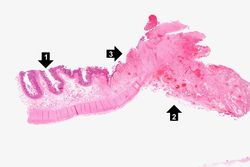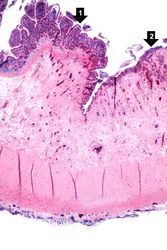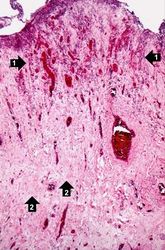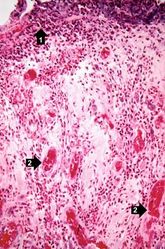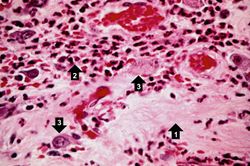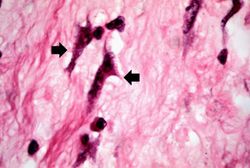Difference between revisions of "IPLab:Lab 12:Radiation Changes"
Seung Park (talk | contribs) |
Seung Park (talk | contribs) |
||
| Line 23: | Line 23: | ||
* <spoiler text="Why are the small intestine and colon so susceptible to radiation injury?">The gastrointestinal tract is very radiosensitive and is frequently affected in all forms of deep radiation. The intestinal epithelium (crypt cells) are particularly radiosensitive due to their high turnover rate. These cell often show nuclear and cellular pleomorphism, mitotic abnormalities, and cell necrosis. Later, ulcerations may appear, along with vascular and connective tissue changes. The late effects of intestinal injury comprise mucosal and submucosal atrophy and fibrosis, occasionally producing intestinal strictures.</spoiler> | * <spoiler text="Why are the small intestine and colon so susceptible to radiation injury?">The gastrointestinal tract is very radiosensitive and is frequently affected in all forms of deep radiation. The intestinal epithelium (crypt cells) are particularly radiosensitive due to their high turnover rate. These cell often show nuclear and cellular pleomorphism, mitotic abnormalities, and cell necrosis. Later, ulcerations may appear, along with vascular and connective tissue changes. The late effects of intestinal injury comprise mucosal and submucosal atrophy and fibrosis, occasionally producing intestinal strictures.</spoiler> | ||
* <spoiler text="Are patients who have been treated with radiation more susceptible to formation of new cancers?">Yes, due to the above-mentioned alterations in nuclear and mitotic activity.</spoiler> | * <spoiler text="Are patients who have been treated with radiation more susceptible to formation of new cancers?">Yes, due to the above-mentioned alterations in nuclear and mitotic activity.</spoiler> | ||
| + | |||
| + | == Additional Resources == | ||
| + | === Reference === | ||
| + | |||
| + | |||
| + | === Journal Articles === | ||
| + | |||
| + | |||
| + | === Images === | ||
| + | |||
| + | |||
| + | == Related IPLab Cases == | ||
| + | |||
{{IPLab 12}} | {{IPLab 12}} | ||
[[Category: IPLab:Lab 12]] | [[Category: IPLab:Lab 12]] | ||
Revision as of 04:27, 23 August 2013
Contents
Clinical Summary[edit]
This 46-year-old white female was found to have prolapse of the uterus two years earlier for which a vaginal hysterectomy had been performed. Study of the specimen demonstrated invasive squamous cell carcinoma of the cervix. Subsequently, she underwent a radical parametrectomy, removal of both tubes and ovaries, and partial resection of the bladder. Six months later, a recurrence of the tumor was treated by 6000 rads to the whole pelvis. Subsequently, the patient developed intermittent small bowel obstruction which resulted in the resection of a segment of ileum. She did well following surgery.
Autopsy Findings[edit]
The surgical specimen consisted of a 13-cm segment of ileum having a luminal circumference of 5 cm. There was a full-thickness tear measuring 2.5 cm in the center of the specimen. On opening the bowel, the mucosa was ulcerated and showed a perforation.
Images[edit]
This high-power photomicrograph of the wall of the ileum shows areas of fibrosis (1), inflammatory cells (2), and abnormal pleomorphic cells (3) in the area of radiation injury. The abnormal morphology of these cells is radiation-induced. These cells are often difficult to distinguish from recurrent tumor cells.
Study Questions[edit]
Additional Resources[edit]
Reference[edit]
Journal Articles[edit]
Images[edit]
Related IPLab Cases[edit]
| |||||
Parametrectomy is the surgical removal of supporting tissues that surround the uterus.
